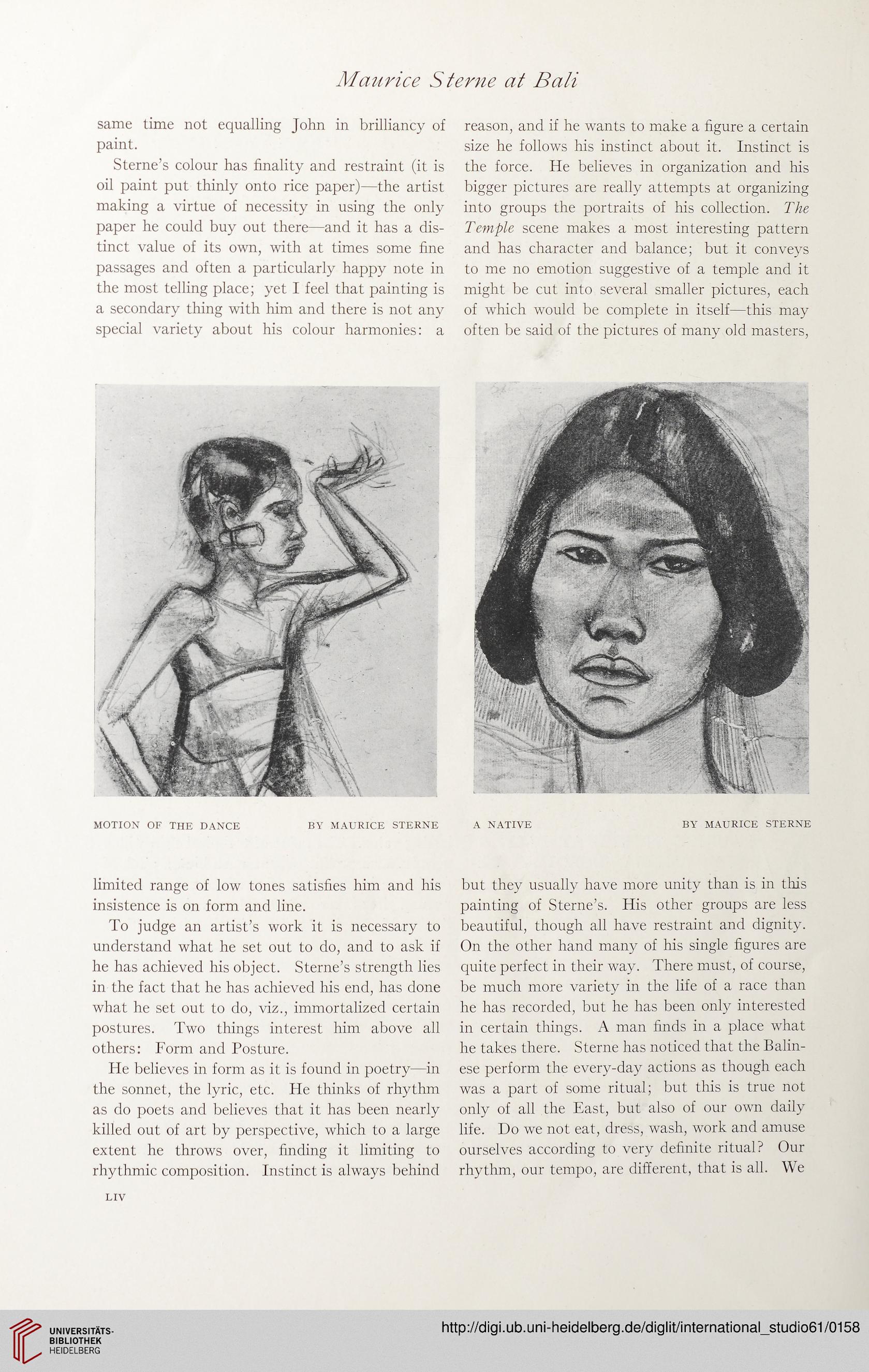Maurice Sterne at Bati
same time not equalling John in brilliancy of
paint.
Sterne’s colour has finality and restraint (it is
oil paint put thinly onto rice paper)—the artist
making a virtue of necessity in using the only
paper he could buy out there—and it has a dis-
tinct value of its own, with at times some fine
passages and often a particularly happy note in
the most telling place; yet I feel that painting is
a secondary thing with him and there is not any
special variety about his colour harmonies: a
reason, and if he wants to make a figure a certain
size he follows his instinct about it. Instinct is
the force. He believes in organization and his
bigger pictures are really attempts at organizing
into groups the portraits of his collection. The,
Temple scene makes a most interesting pattern
and has character and balance; but it conveys
to me no emotion suggestive of a temple and it
might be cut into several smaller pictures, each
of which would be complete in itself—this may
often be said of the pictures of many old masters,
A NATIVE
BY MAURICE STERNE
limited range of low tones satisfies him and his
insistence is on form and line.
To judge an artist’s work it is necessary to
understand what he set out to do, and to ask if
he has achieved his object. Sterne’s strength lies
in the fact that he has achieved his end, has done
what he set out to do, viz., immortalized certain
postures. Two things interest him above all
others: Form and Posture.
He believes in form as it is found in poetry—in
the sonnet, the lyric, etc. He thinks of rhythm
as do poets and believes that it has been nearly
killed out of art by perspective, which to a large
extent he throws over, finding it limiting to
rhythmic composition. Instinct is always behind
but they usually have more unity than is in this
painting of Sterne’s. His other groups are less
beautiful, though all have restraint and dignity.
On the other hand many of his single figures are
quite perfect in their way. There must, of course,
be much more variety in the life of a race than
he has recorded, but he has been only interested
in certain things. A man finds in a place what
he takes there. Sterne has noticed that the Balin-
ese perform the every-day actions as though each
was a part of some ritual; but this is true not
only of all the East, but also of our own daily
life. Do we not eat, dress, wash, work and amuse
ourselves according to very definite ritual? Our
rhythm, our tempo, are different, that is all. We
LIV
same time not equalling John in brilliancy of
paint.
Sterne’s colour has finality and restraint (it is
oil paint put thinly onto rice paper)—the artist
making a virtue of necessity in using the only
paper he could buy out there—and it has a dis-
tinct value of its own, with at times some fine
passages and often a particularly happy note in
the most telling place; yet I feel that painting is
a secondary thing with him and there is not any
special variety about his colour harmonies: a
reason, and if he wants to make a figure a certain
size he follows his instinct about it. Instinct is
the force. He believes in organization and his
bigger pictures are really attempts at organizing
into groups the portraits of his collection. The,
Temple scene makes a most interesting pattern
and has character and balance; but it conveys
to me no emotion suggestive of a temple and it
might be cut into several smaller pictures, each
of which would be complete in itself—this may
often be said of the pictures of many old masters,
A NATIVE
BY MAURICE STERNE
limited range of low tones satisfies him and his
insistence is on form and line.
To judge an artist’s work it is necessary to
understand what he set out to do, and to ask if
he has achieved his object. Sterne’s strength lies
in the fact that he has achieved his end, has done
what he set out to do, viz., immortalized certain
postures. Two things interest him above all
others: Form and Posture.
He believes in form as it is found in poetry—in
the sonnet, the lyric, etc. He thinks of rhythm
as do poets and believes that it has been nearly
killed out of art by perspective, which to a large
extent he throws over, finding it limiting to
rhythmic composition. Instinct is always behind
but they usually have more unity than is in this
painting of Sterne’s. His other groups are less
beautiful, though all have restraint and dignity.
On the other hand many of his single figures are
quite perfect in their way. There must, of course,
be much more variety in the life of a race than
he has recorded, but he has been only interested
in certain things. A man finds in a place what
he takes there. Sterne has noticed that the Balin-
ese perform the every-day actions as though each
was a part of some ritual; but this is true not
only of all the East, but also of our own daily
life. Do we not eat, dress, wash, work and amuse
ourselves according to very definite ritual? Our
rhythm, our tempo, are different, that is all. We
LIV




